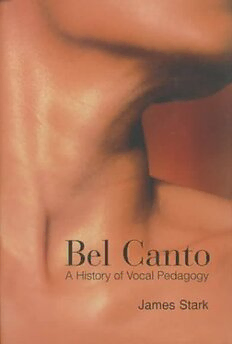
Bel Canto: A History of Vocal Pedagogy PDF
Preview Bel Canto: A History of Vocal Pedagogy
BEL CANTO A History of Vocal Pedagogy In this well documented and highly readable book, James Stark pro- vides a history of vocal pedagogy from the beginning of the bel canto tradition of solo singing in the late sixteenth and early seventeenth cen- turies to the present. Using a nineteenth-century treatise by Manuel Garcia as his point of reference, Stark analyses the many sources that discuss singing techniques and selects a number of primary vocal ‘prob- lems’ for detailed investigation. He also presents data from a series of laboratory experiments carried out to demonstrate the techniques of bel canto. The discussion deals extensively with such topics as the emergence of virtuoso singing, the castrato phenomenon, national differences in sing- ing styles, controversies regarding the perennial decline in the art of singing, and the so-called secrets of bel canto. Stark offers a new definition of bel canto which reconciles historical and scientific descriptions of good singing. His is a refreshing and pro- found discussion of issues important to all singers and voice teachers. james stark is a singer, voice teacher, and musicologist, with a lifelong interest in vocal pedagogy. He has taught at the University of Colorado, the University of Western Ontario, and, for the last twenty-five years, at Mount Allison University in Sackville, New Brunswick. This page intentionally left blank JAMES STARK Bel Canto: A History of Vocal Pedagogy UNIVERSITY OF TORONTO PRESS Toronto Buffalo London www.utppublishing.com © University of Toronto Press Incorporated 1999 Toronto Buffalo London Printed in Canada Reprinted in paperback 2003, 2008 isbn 0-8020-4703-3 (cloth) isbn 0-8020-8614-4 (paper) Printed on acid-free paper Canadian Cataloguing in Publication Data Stark, James A. (James Arthur), 1938– Bel canto : a history of vocal pedagogy / James Stark Includes bibliographical references and index. isbn 0-8020-4703-3 (bound) isbn 0-8020-8614-4 (pbk.) 1. Singing – History. 2. Bel canto. I. Title. mt823.s795 1999 783′.043′09 c99-931643-5 University of Toronto Press acknowledges the financial assistance to its publishing program of the Canada Council for the Arts and the Ontario Arts Council. This book has been published with the help of a grant from the Humanities and Social Sciences Federation of Canada, using funds provided by the Social Sciences and Humanities Research Council of Canada. University of Toronto Press acknowledges the financial support for its publishing activities of the Government of Canada through the Book Publish- ing Industry Development Program (BPIDP). It is the definition of a beast, that he does what he does not understand. Guido d’Arezzo on singers (ca. 1030) This page intentionally left blank Contents preface xi introduction: the search for BEL CANTO xvii 1 THE COUP DE LA GLOTTE: A STROKE OF GENIUS 3 Manuel Garcia II 3 The Larynx 7 Garcia’s Theory of Glottal Closure 11 Garcia’s Theory of the Coup de la glotte 12 The Great Controversy over the Coup de la glotte 14 Modern Views of Vocal Onset 20 Modern Views of Glottal Settings 24 Closed Quotients and Patterns of Vibration 28 Neuromuscular Control Systems 29 Conclusions 30 2 CHIAROSCURO: THE TRACTABLE TRACT 33 Chiaroscuro as an Ideal Voice Quality 33 The Early Treatises 34 Garcia’s Theory of Voice Source versus Vocal Tract 36 Voix sombrée ou couverte 41 Voce aperta and Voce chiusa 42 Helmholtz’s Acoustical Theory 45 Modern Formant Theory 47 Resonance Imagery 51 Conclusions 55 viii Contents 3 REGISTERS: SOME TOUGH BREAKS 57 The Problem of Registers 57 The Two-Register Theory of the Old Italian School 58 Countercurrents to the Two-Register Theory 64 Garcia’s Theory of the Main Registers 67 Voix mixte and Mezza voce 73 Garcia’s Auxiliary Registers 75 The Aftermath of Garcia’s Register Theory 76 Register Theory and Modern Voice Science 81 The Primary Registers 82 Covered Singing 84 Belting 85 Mixed Registers 86 Acoustic Registers 88 Auxiliary Registers 89 Conclusions 90 4 APPOGGIO: THE BREATH BE DAMMED! 91 The Concept of Appoggio 91 The Early Treatises 93 The Eighteenth-century Tutors 95 The Garcia School 96 The Mandl-Lamperti School 99 Stauprinzip and Minimalluft 106 Modern Views of Breath Mechanics 111 Subglottal Pressure, Intensity, and Airflow 114 The Messa di voce 116 Neuromuscular Control Systems 117 Conclusions 118 5 VOCAL TREMULOUSNESS: THE PULSE OF SINGING 121 The Problem of Vocal Tremulousness 121 The Early Treatises 123 Eighteenth-century Sources 130 Nineteenth-century Sources 134 Modern Views of the Trillo 137 Modern Views of Vibrato 138 Neuromuscular Origins of Vibrato 138 Rate, Extent, Intensity, and Timbre 140 Contents ix Respiratory Control of Vibrato 142 Trills and Floridity 143 Vibrato and Expressiveness 144 The Presence and Perception of Vibrato 146 Conclusions 150 6 IDIOM AND EXPRESSION: THE SOUL OF SINGING 153 Problems of Idiom and Expression 153 The Art of Diminutions 154 Caccini’s Affective Vocal Devices 156 Meraviglia, Sprezzatura, and Grazia 160 The Development of Idiomatic Singing 162 Voice Quality 163 Vocal Articulation 163 Floridity 167 The Trill 169 Tempo rubato 173 Categories of Expressive Song 176 Modern Views of Vocal Idiom and Expression 180 Word-Note-Tone Relationships: A Case Study 183 Conclusions 188 7 BEL CANTO: CONTEXT AND CONTROVERSY 189 Réprise: Toward a Definition of Bel canto 189 The Establishment of the Old Italian School of Singing 190 The Castrato Phenomenon 197 National Differences in Singing Styles 204 The Perennial ‘Decline of the Art of Singing’ 216 Coda: The ‘Secrets’ of Bel canto 225 APPENDIX: THE GRONINGEN PROTOCOLS 227 Introduction 227 Glottal Settings 230 Closed Quotients 234 Airflow Rates 236 Subglottal Pressures 238 Voice Quality 240 Messa di voce 245 Mezza voce 246
